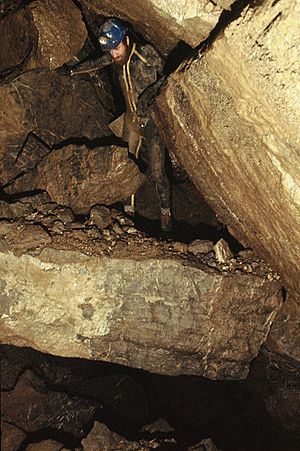St Cuthbert's Swallet facts for kids
Quick facts for kids St Cuthbert's Swallet |
|
|---|---|
 |
|
| Location | Priddy |
| OS grid | ST 543 505 |
| Depth | 145 metres (476 ft) |
| Length | 6.7 kilometres (4 mi) |
| Geology | Limestone |
| Access | Bristol Exploration Club |
| Cave survey | Geological Conservation Review/Bristol Exploration Club |
| Registry | Mendip Cave Registry |
St Cuthbert's Swallet is an amazing cave system found in the Mendip Hills in Somerset, England. It's the second longest and most complex cave in this area. Water that flows into this cave, which is a type of swallet (a place where water sinks into the ground), eventually comes out at the famous Wookey Hole.
This incredible underground world is part of a larger system called the Priddy Caves. It lies beneath the Priddy Pools, which is a special protected area known as a Site of Special Scientific Interest. The cave gets its name because it's located in the St Cuthbert Out parish near Wells.
Contents
Exploring the Cave's History
People were curious about a possible cave here even before 1927. Interest grew a lot when St Cuthbert's Pool suddenly drained away that year!
Finding the Entrance
Attempts to find a way into the cave happened between 1944 and 1953. Finally, in 1953, explorers managed to get inside. They kept pushing the known limits of the cave throughout the 1950s and 1960s.
Deep Dives
In 1969, cavers managed to get past "Sump 1." A sump is a part of a cave passage that is completely filled with water, so you have to dive through it. "Sump 2" has not yet been passed, meaning it's still a mystery waiting to be explored!
How to Visit St Cuthbert's Swallet
Access to St Cuthbert's Swallet is carefully controlled. This is because a very old rule from 1863 said that the stream running through the cave to Wookey Hole must not be polluted.
Controlled Access
Because of this, the cave entrance is locked. The Bristol Exploration Club manages who can enter on behalf of the landowners. Only experienced cavers are allowed to go inside to help protect this special place.
What's Inside St Cuthbert's Swallet
St Cuthbert's Swallet is a great example of a deep phreatic cave system. This means it formed deep underground, completely filled with water, far below the water table.
Cave Structure and Features
The cave has many different levels with inclined passages that look like mazes. It also has rifts (cracks) formed by faults in the rock and some really big chambers. Scientists have found signs of nine different times when sediments (like mud or sand) were laid down, stalagmites grew, and streams carved out the rock. This gives us an amazing record of how the environment changed during the warm and cold periods of the Ice Age.
Amazing Formations and Size
Cavers love St Cuthbert's Swallet because it's so complex and huge! It stretches over 6.7 kilometres (4.2 mi) (about 4 miles) and goes down 145 metres (476 ft) (about 476 feet) deep. It has many large, beautifully decorated chambers. These areas form watery mazes on seven different levels.
Beautiful Calcite Displays
Among its stunning displays are huge and impressive calcite formations. These include areas called 'The Curtains' and 'Cascade'. There's also 'Gour Hall' with a 6.1-metre (20 ft) tall gour (a pool formed by mineral deposits). Other amazing spots are 'The Beehive', Canyon Series, and the 'Balcony' formations in September Chamber. These are considered some of the best in Britain!
Tiny Treasures
The cave also holds mini-formations. You can find floating calcite crystals, over twenty nests of "cave pearls" (small, round mineral formations), and delicate, fern-like crystals less than 4 millimetres (0.16 in) long.
Unique Cave Creatures
St. Cuthbert's Swallet is also important for studying cave insects. One interesting creature found here is Oligaphorura schoetti, a type of springtail. These tiny insects are about 1.7 millimetres (0.07 in) long and are common in many caves. Most of them are female, but a rare male specimen was found in St. Cuthbert's Swallet in 1969!


